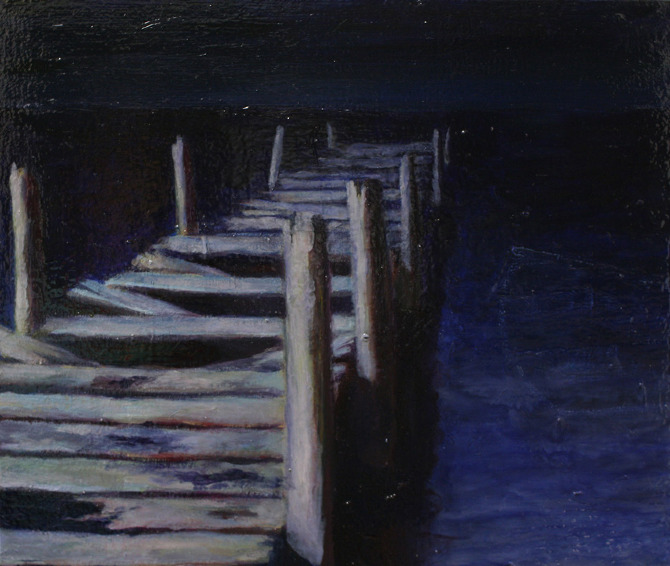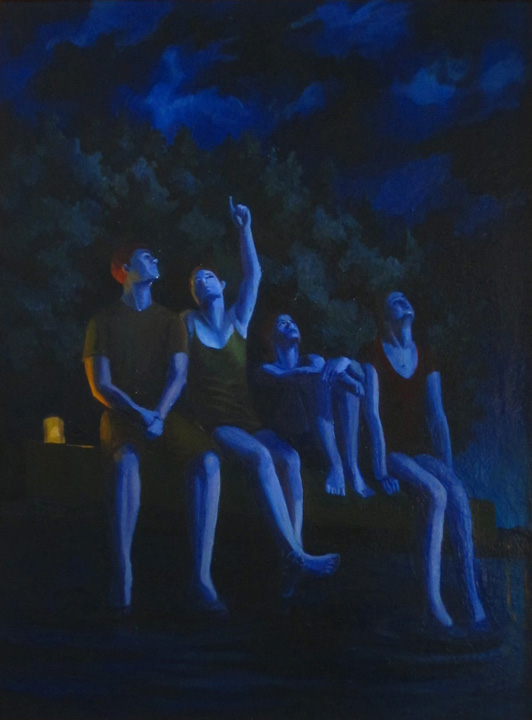I’ve always liked the perspective that the value and meaning of art lies in the eyes of the beholder (which is not to say that artists’ intent doesn’t matter — it can certainly help the beholder see what is there). I’ve read that Melville was unaware of the depth of allegory in Moby-Dick until others pointed it out to him, which doesn’t detract from the book’s greatness at all.
I know it wasn’t Karen’s intention, but I always liked “Dock” because to me it’s a great allegory for… SCIENCE!
Stick with me.
First of all, we’re outside, in nature. There’s water, and there’s sky: real, fundamental nature (very Genesis 1:6-8, very “Mother, Mother Ocean”).
But there’s also the work of humanity. Engineering, mathematics, purpose. Someone used their brains, tradition, and the products of nature (wood) not just to illuminate nature, but to extend into it, and explore.
What’s out over the water? Is it a narrow river, a lake, an ocean? If you walk out to the end of the dock, maybe you could tell.
The planks and the pylons are rigidly, regularly spaced, a hallmark of simple, robust engineering. The pylons get closer together as they recede into the distance according to mathematics of perspective (the discovery of which was, as I understand things, a turning point in art history and a good example of the interplay between science and art).
Because the perspective of the painting is true, the dock doesn’t just head out over the water, but heads straight into the distant, unseen horizon. As if extending the dock just a little bit farther you wouldn’t just reach the distant shore, but the sky itself.
Maybe that’s silly — even if you never reach the sky, you couldn’t possibly extend the dock to the other side of an ocean. But in trying, you’d learn a lot about the ocean; and about how you could do it.
After all, a dock isn’t just for walking on; it’s a launching point for boats. More complex engineering that allows you to cross rivers, lakes, and even oceans. So maybe you can see what’s on the other side. With a dock you can explore this fundamental nature, maybe modestly (just fishing for minnows), maybe with big plans (let’s sail to the Galapogos!), or grand ambition (is this the Shore of the Cosmic Ocean?)
The new version, “boardwalk” steps back. The dock is longer now, and we can see that it extends back into the tall grass (much like the dock at our parents’ house). This adds whole new dimensions of biology to the allegory. The grass is starting to come up through the planks and lean over the edges. Nature is going to reclaim its own; but that’s a false dichotomy. We use nature to learn about nature.
But in both versions, the dock isn’t in very good shape. Our engineering isn’t perfect, our attempts at illuminating the darkness sometimes thwarted by nature itself. Or, old ways of doing things become obsolete and discarded. Maybe this body of water isn’t interesting any more; maybe we found better launch elsewhere; maybe someone built a better dock.
But I bet it still works.
Someone built this dock so humans could walk on water. Don’t you want to wander out to the end and see what’s there?



